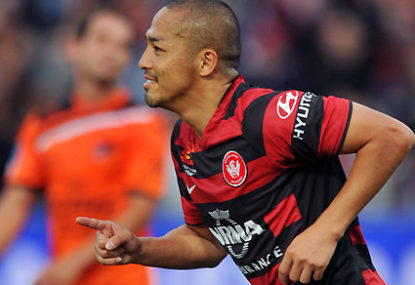Young excellence, promotion battles, and a happy farewell: The Australian team of the week from players around the globe
Even though St.Pauli ultimately lost a high-scoring affair, Jackson Irvine was a standout, as well as scoring a late goal.

It would be easy to point to Shinji Ono’s first goal for the Wanderers – a late penalty against Brisbane to steal the win – as the moment in which he asserted himself in Australian football.
But the reality is that his performance a week later in the second ever Sydney derby was far more impressive.
Ono didn’t tangibly affect the result with a goal – although he played in a fine cross for Michael Beauchamp’s goal – but he was the game’s key player, demonstrating outstanding vision and supreme awareness of space to allow the Wanderers to dominate the midfield.
Given both sides were actively trying to compete in that zone, this proved crucial.
As per usual, Ono was deployed in the central playmaking position of Tony Popovic’s 4-2-3-1 formation which, as the preview noted, is focused on ‘good structure and defensive organisation’.
Ono’s role is simple: to provide creativity high up the pitch and play in support of the lone striker, whether that be Dino Kresinger or Joey Gibbs.
Against Sydney FC, Gibbs was handed the start, meaning Ono sat in a pocket just behind, looking to collect passes from midfield and thread through balls behind the defence (whereas with Kresinger, Ono tries to collect second balls from the hold-up play of the physical Croatian).
Defensively
Although he was a designated playmaker, Ono generally pushed up alongside Gibbs to form a duo that would block passes from Sydney’s centre-backs into midfield.
Despite possessing two fine passers in deep midfield with Terry Antonis and Jason Culina, Sydney rarely played the ball out from the back, with Pascal Bosschaart and Adam Griffiths forced to play long, ambitious passes into the channels.
Attack
When the Wanderers had possession, Ono focused on positioning himself between the lines of Sydney’s midfield and defence, and with no holding player dedicated to his zone, he ran riot.
Sydney operated a midfield trio of Culina, Antonis and Rhyan Grant in a 4-2-3-1, with the latter pushing forward to support Blake Powell. Antonis and Culina were more defensively inclined and took turns to go forward, but were often drawn up the pitch towards the Wanderers’ pivot of Iacopo La Rocca and Mateo Poljak.
Coupled with the fact that the three sometimes rotated positions, which added to the confusion of who was picking up Ono, compounded Sydney’s problems – Tahj Minniecon’s late chance was a fine example of this trend.
Sydney v playmakers
Sydney has had similar problems defending against playmakers before, when Central Coast’s Tom Rogic ran rampant between the lines in the embarrassing 7-2 loss under Ian Crook. The former coach insisted on pressing high up the pitch, a strategy unsuited to the midfield pairing of Paul Reid and Ali Abbas, and Rogic had plenty of space in dangerous attacking positions.
Sydney’s much maligned captain Terry McFlynn missed both of those games, and although the Irishman is having an extremely poor season, he does have the defensive awareness to keep a more disciplined position at the base of the midfield, and his work ethic against the Melbourne Heart a fortnight ago was key to Fred’s quiet performance in that fixture. Still, his form has continued to plummet since the start of the 2011/12 season.
Even in that fixture against the Heart, Sydney allowed one midfielder to move forward and press the ball possessor. As discussed in the aftermath of Ian Crook’s resignation, it is a failure to address the midfield zone that has proved their downfall.
In an attempt to win the ball back, Sydney are robbing themselves of numerical equality in a crucial zone and allowing intelligent players the room to influence the game – another example of this was in the 2-1 defeat against Adelaide.
Drifting
Returning to Ono, the playmaker also had a second responsibility of drifting to the right flank to help overload Fabio at left-back. The Brazilian has been much improved this season but has struggled in recent weeks due to a lack of protection from Yairo Yao, and Sydney’s vulnerability down that flank was a key feature of the aforementioned defeat to Adelaide.
Ono’s focus on moving to the right was obvious, and in doing so, he allowed Youssoff Hersi to continually storm past Fabio into dangerous positions. Jerome Polenz offered sporadic support but Western Sydney’s superiority on that flank was already asserted by their simple two-on-one overloads, as underlined by the build-up to the first goal, where Polenz advanced high up the pitch and allowed Hersi inside.
Ono’s propensity for drifting from flank to flank was a new development – previously, he’s been fairly static in keeping central positions, which has seen him struggle to compete, notably against Adelaide United – but by moving laterally across the pitch, it becomes more difficult to mark him, and easier for Western Sydney’s wide players to influence the game.